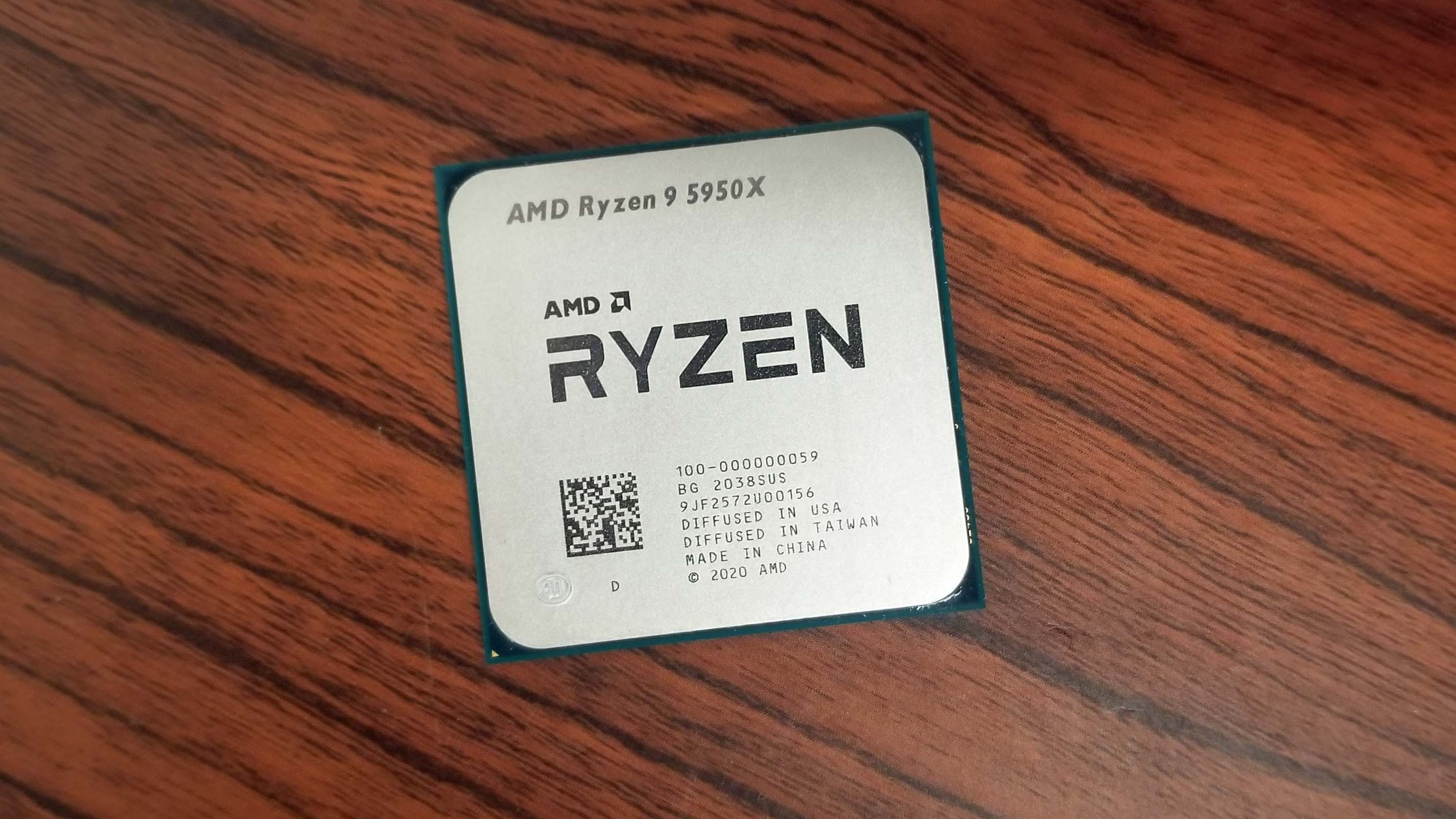Why you can trust Tom's Hardware
To the world of enthusiasts that have long been pining for a huge gen-on-gen upgrade, AMD’s Ryzen 9 5950X and Ryzen 9 5900X deliver an almost unbelievable amount of performance improvement over not only AMD’s previous-gen Ryzen processors, but also over Intel’s Comet Lake flagships. The fact that the Ryzen 9 chips regularly break the 5GHz barrier, even at stock settings, is simply icing on the cake.
AMD’s clever re-use of the proven Ryzen SoC design and I/O Die, not to mention the now-mature 7nm TSMC process, allowed the company to focus its resources on delivering a massively redesigned core architecture that takes a big step forward on IPC throughput, which in turn yields higher performance and more power efficiency.
AMD’s decision to unify the L3 cache pays big dividends in applications that profit from low-latency memory access, with gaming being the perfect example. Meanwhile, more nuanced improvements to the branch predictor and front end expose faster performance across the board, yielding big gains in both single- and multi-threaded workloads.
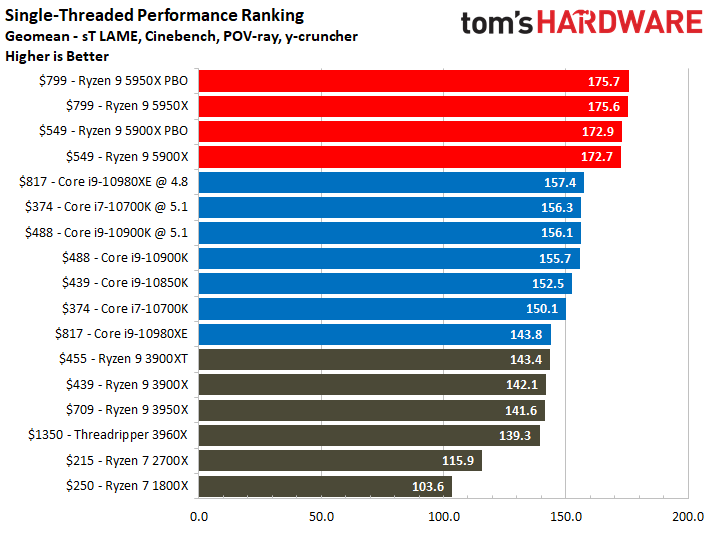
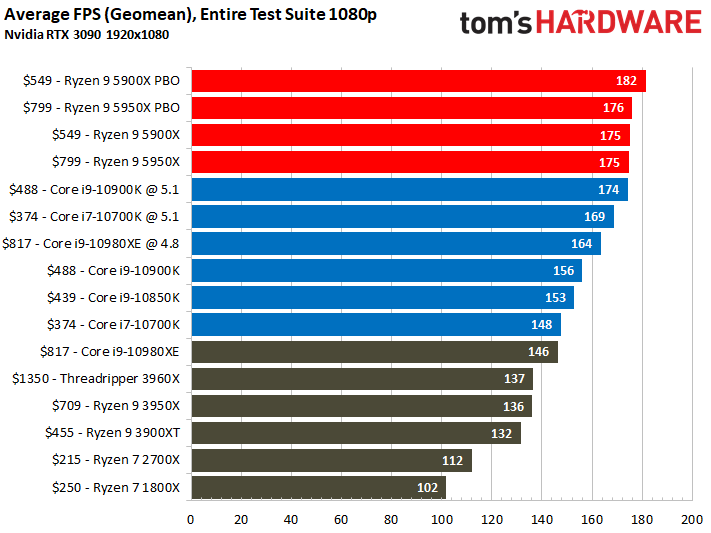
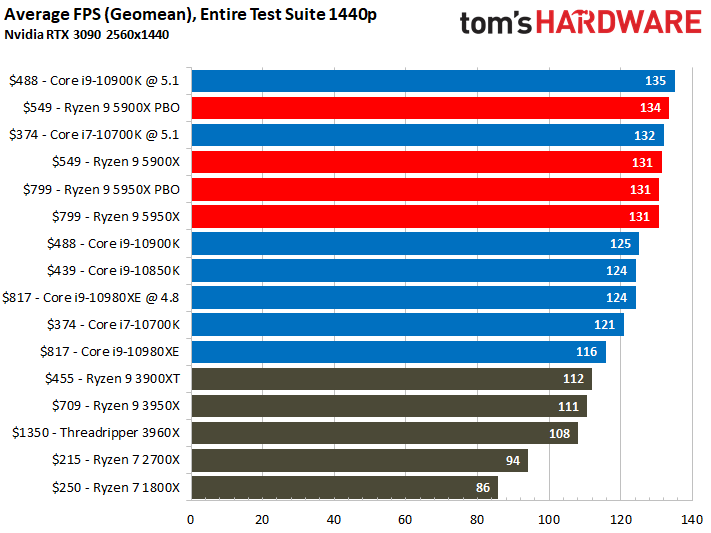
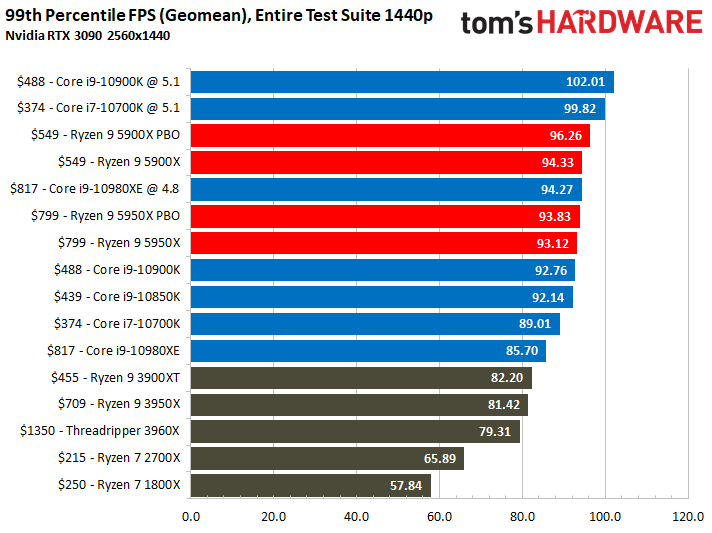
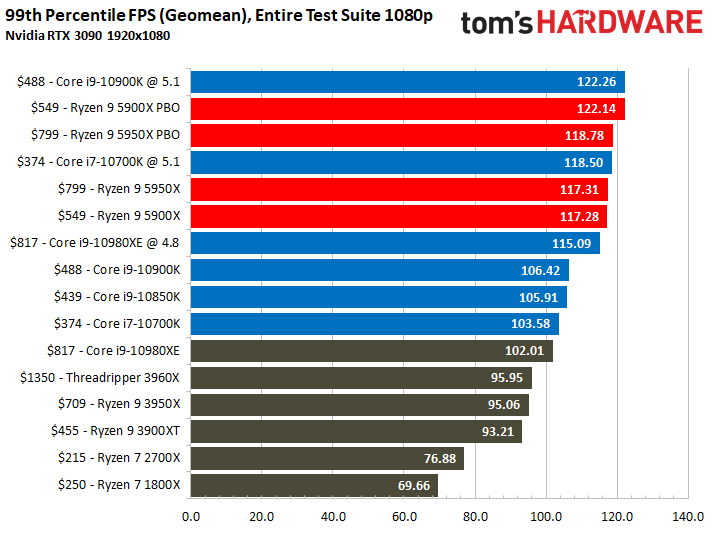
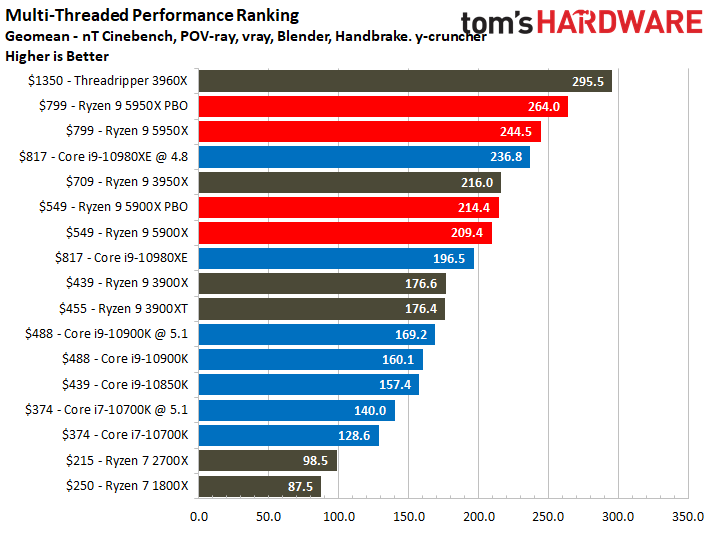
As we can see in our cumulative gaming and application measurements above, AMD has finally scored a clean sweep in 1080p gaming along with performance in single- and multi-threaded applications. That single-threaded ranking above isn't 'just' Cinebench, either — it's a cumulative measure of several different types of workloads. Perhaps most telling, the stock Ryzen 9 processors beat Intel's highly-overclocked flagships not only in gaming, but also in single-threaded performance.
We certainly couldn't have imagined this possibility when AMD launched the Ryzen series a mere three years ago. We test the fastest chips on the planet, and these types of massive generational performance increases are amazing, even to us.
AMD's path from the bottom of the performance charts to the top was a hard-fought win, but while the company now holds the performance crown, it has left Intel a sliver of room to operate as the budget alternative.
The Ryzen 5000 series processors land at significantly higher recommended price points than the previous-gen models, and you'll have to bring your own cooler. The price for entry on the low end is also higher than we're accustomed to, not to mention that you'll have to drop an extra $150 to move up from the six-core Ryzen 5 5600X to the eight-core Ryzen 7 3800X. At least 500-series motherboards are plentiful, and we now have B550 motherboards for budget platforms.
Get Tom's Hardware's best news and in-depth reviews, straight to your inbox.
Zen 3’s gaming performance is nothing short of spectacular. However, as we've noted with previous AMD CPU reviews, many of those gains won’t be noticeable to users with lesser graphics cards. The tables have turned, and now Intel CPUs are the ones that are "basically just as fast as AMD" with anything short of the RTX 3080. On the other hand, AMD's upcoming Radeon RX 6800 XT could offer additional gaming benefits over Intel, thanks to Smart Memory Access.
Unfortunately, AMD’s suggested retail pricing rarely has any relation to reality at the checkout lane, so it’s hard to project where pricing will land in a few months. This much is certain, though: AMD will have no problem selling its pricey new silicon to enthusiasts looking for every last bit of performance on a modern platform.
For now, there’s no reason to recommend an Intel Comet Lake processor on the high end unless you need integrated graphics, so we’ll have to wait until Intel slashes pricing to reflect the reality that it is now the budget alternative. Meanwhile, AMD's Ryzen 5 5600X is incredibly potent in the mid-range, beating even Intel's beastly Core i9-10900K in 1080p gaming, which you can read about in our Ryzen 5 5600X review. We have yet to test the Ryzen 7 5800X, so there could be at least some competition in the mid-range — but there is certainly no competition at the top.
Intel does have Rocket Lake waiting in the wings, but those chips won't land until next year and will top out at a mere eight cores. We don't foresee enough of a performance increase from Intel's new architecture etched onto the 14nm process to really tip the scales against AMD's core-heavy models, meaning AMD could reside at the top of the desktop PC game for at least a year, if not longer.
MORE: Best CPUs
MORE: Intel and AMD Processor Hierarchy Comparisons
MORE: All CPUs Content
Current page: Taking the Silicon Throne
Prev Page AMD Ryzen 9 5950X and Ryzen 9 5900X Adobe, SPECworkstation 3, SPECviewperf 2020 Benchmarks
Paul Alcorn is the Editor-in-Chief for Tom's Hardware US. He also writes news and reviews on CPUs, storage, and enterprise hardware.
-
everettfsargent https://forums.tomshardware.com/threads/amd-ryzen-9-5950x-and-5900x-review-zen-3-breaks-the-5-ghz-barrier.3659689/Reply
Reposting a three week old review? -
everettfsargent Oh and Core i9-10980XE $815 (retail) "You can find the 18-core 36-thread Core i9-10980XE for $815 at several retailers ... " is still a bald-faced lie three weeks later! :(Reply -
VTXcnME Humorous the 'cons' that list price increases of $50. For the last decade, Intels flagship processor has been half again as much as the current Ryzen5000 and so few tech sites batted an eye about it. And it's been a bit since I shopped intel chips, but last I checked, Intel hasn't been bundling coolers with their chips for a while? Someone who follows intel might be able to provide me some guidance there.Reply
As a home building enthusiast (for the last decade or so) this is a very exciting time having legit competition between team red and team blue. Even AMD and Nvidia is getting interesting! A fantastic time to be a home builder. I can't wait to see how intel counter punches here. Should be an interesting decade ahead. -
veldrane2 mmmmkay ........Reply
But can it break the "be actually in stock" barrier ?
Which benchmark tools give us those results ?
I mean ... It does look cute somewhere in the fluffy land of benchmarks and future upcoming products even though "technically" its not a future product. -
JordonB Reply
AMD 5950 selling at $695 on Amazon. It was there last night for sale 1 per person. I was happily surprised. I would have purchased it but had purchased a 3900X 4 months ago.veldrane2 said:mmmmkay ........
But can it break the "be actually in stock" barrier ?
Which benchmark tools give us those results ?
I mean ... It does look cute somewhere in the fluffy land of benchmarks and future upcoming products even though "technically" its not a future product. -
VTXcnME ReplyJordonB said:AMD 5950 selling at $695 on Amazon. It was there last night for sale 1 per person. I was happily surprised. I would have purchased it but had purchased a 3900X 4 months ago.
aaannnnd it's gone again. LOL -
Co BIY These will sell at the premium prices they are asking for. I don't see why they shouldn't. Past AMD chips sold below msrp because they had to be "value" chips but these are performance leaders.Reply
They also probably have limited ability to greatly increase production since TSMC is booked up so they aren't going to increase the volume sold by lowering prices. -
Trustdesa ReplyVTXcnME said:Humorous the 'cons' that list price increases of $50. For the last decade, Intels flagship processor has been half again as much as the current Ryzen5000 and so few tech sites batted an eye about it. And it's been a bit since I shopped intel chips, but last I checked, Intel hasn't been bundling coolers with their chips for a while? Someone who follows intel might be able to provide me some guidance there.
As a home building enthusiast (for the last decade or so) this is a very exciting time having legit competition between team red and team blue. Even AMD and Nvidia is getting interesting! A fantastic time to be a home builder. I can't wait to see how intel counter punches here. Should be an interesting decade ahead.
It also humorous how fanboys cried at Intel "robbing" "price gauging" but now that their master AMD is showing to be as anti consumer, even more so with GPU fanboys defend what they were crying about before. They are both corporates, sorry I hope it won't come as a shook to you :)
It must be sad being a fanboys of a brand making silicon chip...like really sad. Consumer excited by their masters charging more, imagine if Intel or Nvidia or ATI, or S3 or any tech company charged £50 more each generation, a CPU or GPU or Monitor would cost you ehmmm £50k circa if we start from 8086 onwards... I mean guys if you have no economics basis and your jobs do not involve finance perhaps you should not comment :) -
VTXcnME ReplyTrustdesa said:It also humorous how fanboys cried at Intel "robbing" "price gauging" but now that their master AMD is showing to be as anti consumer, even more so with GPU fanboys defend what they were crying about before. They are both corporates, sorry I hope it won't come as a shook to you :)
It must be sad being a fanboys of a brand making silicon chip...like really sad. Consumer excited by their masters charging more, imagine if Intel or Nvidia or ATI, or S3 or any tech company charged £50 more each generation, a CPU or GPU or Monitor would cost you ehmmm £50k circa if we start from 8086 onwards... I mean guys if you have no economics basis and your jobs do not involve finance perhaps you should not comment :)
Remember the time Intel's flagship chip was like $1,400/USD? And intel fanboys cried and fawned in the glory of it's brilliance.
Now AMD has a chip that's more powerful that that, that's still listed for about half of what that intel chip was and it's "price gouging" :ROFLMAO::ROFLMAO::ROFLMAO:
Fanboys of any brand are obnoxious. As an end point consumer, I'm just happy to see actual legit competition between the major CPU and GPU communities. -
drivinfast247 Reply
Not sure if joking or.........Trustdesa said:It also humorous how fanboys cried at Intel "robbing" "price gauging" but now that their master AMD is showing to be as anti consumer, even more so with GPU fanboys defend what they were crying about before. They are both corporates, sorry I hope it won't come as a shook to you :)
It must be sad being a fanboys of a brand making silicon chip...like really sad. Consumer excited by their masters charging more, imagine if Intel or Nvidia or ATI, or S3 or any tech company charged £50 more each generation, a CPU or GPU or Monitor would cost you ehmmm £50k circa if we start from 8086 onwards... I mean guys if you have no economics basis and your jobs do not involve finance perhaps you should not comment :)
